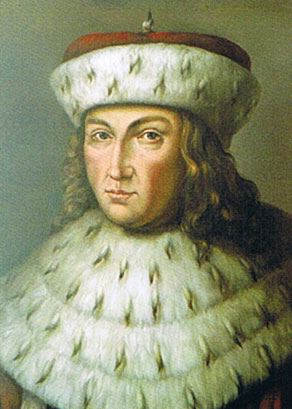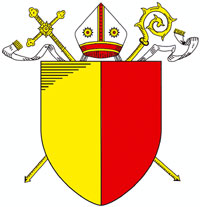|
Dorothea Of Brandenburg, Duchess Of Saxe-Lauenburg
Dorothea of Brandenburg (1446 – March 1519) was a princess of Brandenburg by birth and by marriage Duchess of Saxe-Lauenburg. Life Dorothea was the eldest child of Elector Frederick II of Brandenburg (1413–1471) from his marriage to Catherine (1421–1476), daughter of Elector Frederick I of Saxony. She married on 12 February 1464 in Lüneburg Duke John V of Saxe-Lauenburg (1439–1507). As she was oldest daughter of the Elector Frederick, who had no surviving sons, the marriage agreement was important. In addition to a florins dowry, Frederick promised his son-in-law everything that he could legally leave to his daughter. Later, however, Frederick abdicated in favour of his younger brother Albert Achilles, so as to keep his possessions in the family. Frederick also failed to pay the dowry to his son-in-law. This led Dorothea's uncle John the Alchemist to compare himself with the Elector Frederick in 1482.Adolph Friedrich Riedel: ''Codex diplomaticus Brandenburgensis: ... [...More Info...] [...Related Items...] OR: [Wikipedia] [Google] [Baidu] |
Frederick II, Elector Of Brandenburg
Frederick II of Brandenburg () (19 November 1413 – 10 February 1471), nicknamed "the Iron" (''der Eiserne'') and sometimes "Irontooth" (''Eisenzahn''), was a Prince-elector of the Margraviate of Brandenburg from 1440 until his abdication in 1470, and was a member of the House of Hohenzollern. Biography Frederick II was born at Tangermünde Castle (German: ''Burg Tangermünde''), when Tangermünde was within the Margraviate of Brandenburg, to Frederick I, Brandenburg's first Hohenzollern ruler, and his wife Elizabeth, daughter of Frederick, Duke of Bavaria-Landshut, and Maddalena Visconti. The latter was a daughter of Bernabò Visconti and Beatrice della Scala. As the second son, his brothers included John the Alchemist and Albert Achilles, both of whom also ruled Brandenburg as margraves. In 1421, at age 8, Frederick was betrothed to Hedwig Jagiellon, but she died on 8 December 1431, before the marriage could take place. When Frederick I retired in 1437, he compensated hi ... [...More Info...] [...Related Items...] OR: [Wikipedia] [Google] [Baidu] |
Canon (priest)
A canon (from the Latin , itself derived from the Greek , , "relating to a rule", "regular") is a member of certain bodies in subject to an ecclesiastical rule. Originally, a canon was a cleric living with others in a clergy house or, later, in one of the houses within the precinct of or close to a cathedral or other major church and conducting his life according to the customary discipline or rules of the church. This way of life grew common (and is first documented) in the 8th century AD. In the 11th century, some churches required clergy thus living together to adopt the rule first proposed by Saint Augustine that they renounce private wealth. Those who embraced this change were known as Augustinians or Canons Regular, whilst those who did not were known as secular canons. Secular canons Latin Church In the Latin Church, the members of the chapter of a cathedral (cathedral chapter) or of a collegiate church (so-called after their chapter) are canons. Depending on the title ... [...More Info...] [...Related Items...] OR: [Wikipedia] [Google] [Baidu] |
Frederick III, Landgrave Of Thuringia
Frederick III, the Strict (''Friedrich III. der Strenge''; 14 December 1332, Dresden – 21 May 1381, Altenburg), Landgrave of Thuringia and Margrave of Meissen, was the son of Frederick II, Margrave of Meissen and Mathilde of Bavaria.Harald Schieckel: Friedrich III. der Strenge. In: Neue Deutsche Biographie (NDB). Band 5, Duncker & Humblot, Berlin 1961, ISBN 3-428-00186-9 He took over the government for his brothers William, Balthasar and Ludwig (Bishop of Bamberg) after the death of their father in 1349. One year later the Emperor gave the Margraviate of Meissen to the four brothers jointly. In 1368 common government began, afterwards the brothers changed rulership every two years. In 1379 they divided their possessions. After Frederick III's death, Meissen was divided between his three sons and Thuringia was inherited by his brothers; it later passed to his nephew Frederick IV, Landgrave of Thuringia, son of his brother Balthasar, and was ultimately inherited by Frede ... [...More Info...] [...Related Items...] OR: [Wikipedia] [Google] [Baidu] |
Maddalena Visconti
Maddalena Visconti (1366 – 17 July 1404) was a daughter of Bernabò Visconti and his wife Beatrice Regina della Scala. Maddalena was Duchess of Bavaria-Landshut by her marriage to Frederick, Duke of Bavaria. Family Maddalena was born in Milan and was the twelfth of seventeen children born to her parents. Maddalena's maternal grandparents were Mastino II della Scala and his wife Taddea da Carrara. Her paternal grandparents were Stefano Visconti and his wife Valentina Doria. Her father, Bernabò was a cruel and ruthless despot, and an implacable enemy of the Church. He seized the papal city of Bologna, rejected the Pope and his authority, confiscated ecclesiastical property, and forbade any of his subjects to have any dealings with the Curia. He was excommunicated as a heretic in 1363 by Pope Urban V, who preached crusade against him. When Bernabò was in one of his frequent rages, only Beatrice Regina (her mother) was able to approach him. Marriage Maddalena married on 2 ... [...More Info...] [...Related Items...] OR: [Wikipedia] [Google] [Baidu] |
Frederick, Duke Of Bavaria
Frederick (1339 – 4 December 1393) was Duke of Bavaria from 1375. He was the second son of Stephen II and Elizabeth of Sicily. Family His maternal grandparents were Frederick III of Sicily and Eleanor of Anjou. Her parents were Charles II of Naples and Maria Arpad of Hungary. Maria was a daughter of Stephen V of Hungary and his wife, queen Elisabeth, who was daughter of Zayhan of Kuni, a chief of the Cuman tribe and had been a pagan before her marriage. Stephen V was a son of Béla IV of Hungary and Maria Laskarina. Maria Laskarina was a daughter of Theodore I Lascaris and Anna Angelina. Anna was daughter of Eastern Roman Emperor Alexios III Angelos and Euphrosyne Doukaina Kamatera. Reign From 1375 to 1392 he ruled Bavaria-Landshut jointly with his brothers Stephen III and John II and managed to administer the richest part of the duchy, the region of Landshut which he also kept after the division of Bavaria among the brothers in 1392, when Bavaria-Landshut was reduce ... [...More Info...] [...Related Items...] OR: [Wikipedia] [Google] [Baidu] |
Elisabeth Of Meissen
Elisabeth of Meissen, Burgravine of Nuremberg (22 November 1329 – 21 April 1375) was the daughter of Frederick II, Margrave of Meissen and Mathilde of Bavaria and a member of the House of Wettin. Marriage and children She was born in Wartburg. On 7 September 1356, at the age of twenty six, she married Frederick V, Burgrave of Nuremberg in Jena. In 1357 her husband succeeded to the title, and from that time until her death in 1375, she was styled as Burgravine of Nuremberg. Together Frederick and Elisabeth had nine children, seven girls and two boys, who survived to adulthood: # Elisabeth (1358–26 July 1411, Heidelberg), married in Amberg 1374 to Rupert of Germany. # Beatrix (c. 1362, Nuremberg–10 June 1414, Perchtoldsdorf), married in Vienna 1375 Duke Albert III of Austria # Anna (c. 1364–after 10 May 1392), a nun in Seusslitz. # Agnes (1366 – 22 May 1432), Convent in Hof (1376–1386) married in Konstance 1386 Baron Friedrich of Daber, Returned to Co ... [...More Info...] [...Related Items...] OR: [Wikipedia] [Google] [Baidu] |
Frederick V, Burgrave Of Nuremberg
Frederick V of Nuremberg (before 3 March 1333 – 21 January 1398) was a Burgrave (''Burggraf'') of Nuremberg, of the House of Hohenzollern. Life He was the elder son of John II, Burgrave of Nuremberg and Elisabeth of Henneberg. From the death of his father in 1357, Frederick bore the title of ''Burgrave'' and so was responsible for the protection of the strategically significant imperial castle of Nuremberg. His zeal in the imperial cause led Charles IV to elevate him in 1363 to be the first Burgrave of royal rank. After his death, his sons divided their inheritance. The eldest son, John III became the first Margrave of Brandenburg-Kulmbach. Johann's brother Frederick VI became the next Burgrave of Nuremberg as well as the first Margrave of Brandenburg-Ansbach. Frederick VI went on to become the first Hohenzollern Elector of Brandenburg. Family and children He married in 1356 Elisabeth of Meissen, daughter of Frederick II, Margrave of Meissen and Matilda of Bavaria. T ... [...More Info...] [...Related Items...] OR: [Wikipedia] [Google] [Baidu] |
Catherine Of Brunswick-Lüneburg
Catherine of Brunswick-Lüneburg (1395 – 28 December 1442, Grimma) was a member of the House of Welf, a princess of Brunswick-Lüneburg and by marriage, the Electress of Saxony. Life Catherine was the only daughter and second child of the Duke Henry I of Brunswick-Lüneburg († 1416) from his first marriage to Sophie († June 1400), daughter of Duke Wartislaw VI of Pomerania. As a 7-year-old she married on 7 February 1402 Margrave Frederick IV "the Warlike" of Meissen (1370–1428), who in 1425 became the first Elector of Saxony, as Frederick I. The elector lost a large part of his army in the Hussite Wars in a battle in 1425 at Most. During Frederick's absence, Electress Catherine organized another army of 20,000 men, which rushed to Frederick's aid, but was defeated devastatingly in the Battle of Aussig in 1426. Catherine spent time with her husband, but more frequently alone, at Mildenstein Castle in Leisnig, which thereby developed into a private residence ... [...More Info...] [...Related Items...] OR: [Wikipedia] [Google] [Baidu] |
Elisabeth Of Bavaria, Electress Of Brandenburg
Elisabeth of Bavaria-Landshut (1383 – 13 November 1442), nicknamed "Beautiful Beth", was an Electress of Brandenburg. Life Elizabeth was a daughter of Duke Frederick "the Wise" of Bavaria-Landshut and his second wife Maddalena Visconti. On 18 September 1401 she married Frederick VI of Hohenzollern, Burgrave of Nuremberg, who was promoted to Elector of Brandenburg in 1415 and ruled as "Elector Frederick I". During her husband's long journeys to Italy, Hungary, and to the Council of Constance, she represented him wisely despite the great political problems Brandenburg was experiencing at the time. She is the ancestress of the royal line of the House of Hohenzollern by her third son Albert III Achilles, Elector of Brandenburg. Issue With Frederick she had ten children: # Elisabeth (1403–31 October 1449, Liegnitz), married: ## in Konstanz 1418 Duke Louis II of Brieg and Legnica (1380/5–1436); ## in 1438 Duke Wenzel I of Teschen (1413/18–1474). # John "the Alch ... [...More Info...] [...Related Items...] OR: [Wikipedia] [Google] [Baidu] |
Frederick I, Elector Of Brandenburg
Frederick (Middle High German: ''Friderich'''','' Standard German: ''Friedrich''; 21 September 1371 – 20 September 1440) was the last Burgrave of Nuremberg from 1397 to 1427 (as Frederick VI), Margrave of Brandenburg-Ansbach from 1398, Margrave of Brandenburg-Kulmbach from 1420, and Elector of Brandenburg (as Frederick I) from 1415 until his death. He became the first member of the House of Hohenzollern to rule the Margraviate of Brandenburg. Biography Frederick was born in Nuremberg, the second-born son of Burgrave Frederick V (1333–1398) and the Wettin princess Elisabeth of Meissen. He entered early into the service of his brother-in-law, the Habsburg duke Albert III of Austria. After Albert's death in 1395, he fought on the side of the Luxembourg king Sigismund of Hungary against invading Ottoman forces. He and his elder brother John, husband of Sigismund's sister Margaret of Bohemia, fought in the 1396 Battle of Nicopolis where they suffered a disastrous defe ... [...More Info...] [...Related Items...] OR: [Wikipedia] [Google] [Baidu] |
Henry IV, Duke Of Brunswick-Grubenhagen
Duke Henry IV of Brunswick Grubenhagen (1460 – 6 December 1526, Salzderhelden, now part of Einbeck) was a member of the Guelph dynasty and was Prince of Brunswick-Grubenhagen. Life Henry was the son of Henry III of Brunswick-Grubenhagen and Margaret, a daughter of the Duke Jan I of Żagań and Scholastica of Saxe-Wittenberg. After his father's death in 1464, he succeeded him as Prince of Grubenhagen. Since he was a minor, he was under the guardianship of his uncle, Albert II until he came of age in 1479. After 1479, he divided the principality with Albert. Albert received Osterode Castle and Herzberg Castle; Henry received Heldenburg Castle. They ruled Grubenhagen Castle jointly. After Albert II died in 1485, Henry became guardian of his underage cousin Philip I. When Henry died childless in 1526, Philip I inherited his territory and thereby reunited all parts of Grubenhagen. Marriage Henry married on 26 August 1494 in Einbeck with Elisabeth of Saxe-Lauenburg (died ... [...More Info...] [...Related Items...] OR: [Wikipedia] [Google] [Baidu] |
Prince-Bishop Of Hildesheim
This list records the incumbents of the Roman Catholic Diocese of Hildesheim (german: link=no, Bistum Hildesheim). Between 1235 and 1803 the bishops simultaneously officiating as rulers of princely rank (prince-bishop) in the Prince-Bishopric of Hildesheim (german: link=no, Hochstift Hildesheim), a state of imperial immediacy within the Holy Roman Empire. Hildesheim is the seat of the bishops and the cathedral chapter. Titles of the incumbents of the Hildesheim See Between 1235 and 1803 the elected and papally confirmed bishops of the Hildesheim See were additionally imperially invested princely power as prince-bishops. In 1235 part of the Hildesheim diocesan territory, the episcopal and capitular temporalities (Stift) were disentangled from the Duchy of Brunswick and Lunenburg and became an own territory of imperial immediacy called Prince-Bishopric of Brunswick and Lunenburg (german: link=no, Hochstift Hildesheim), a vassal of the Holy Roman Empire. The prince-bishopric wa ... [...More Info...] [...Related Items...] OR: [Wikipedia] [Google] [Baidu] |




